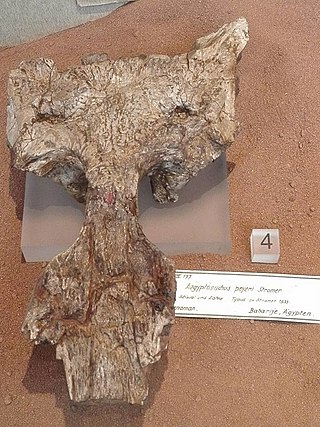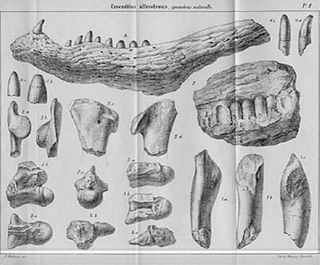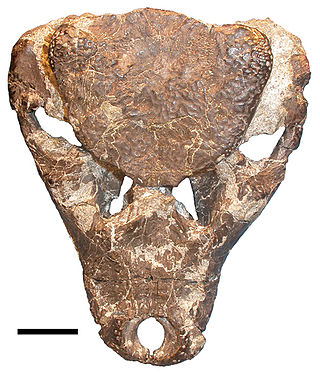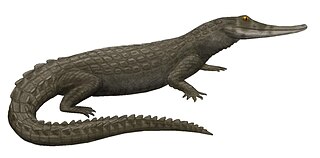
Allodaposuchus is an extinct genus of crocodyliforms that lived in what is now southern Europe during the Campanian and Maastrichtian stages of the Late Cretaceous. Although generally classified as a non-crocodylian eusuchian crocodylomorph, it is sometimes placed as one of the earliest true crocodylians. Allodaposuchus is one of the most common Late Cretaceous crocodylomorphs from Europe, with fossils known from Romania, Spain, and France.
Pachycheilosuchus is an extinct genus of neosuchian from the Early Cretaceous of Texas, United States. Previously known, in part, as the "Glen Rose form", this crocodylomorph is notable for its procoelous vertebrae, otherwise found only in derived eusuchian crocodilians, a thick margin on the maxillae, and a shield of armor on the neck formed by the fusion of six individual scutes.

Borealosuchus is an extinct genus of crocodyliforms that lived from the Late Cretaceous to the Eocene in North America. It was named by Christopher Brochu in 1997 for several species that had been assigned to Leidyosuchus. The species assigned to it are: B. sternbergii, the type species, from the Maastrichtian of Colorado, Montana, North Dakota, South Dakota, and Wyoming; B. acutidentatus, from the Paleocene of Saskatchewan; B. formidabilis, from the Paleocene of North Dakota; B. griffithi, from the Paleocene of Alberta; and B. wilsoni, from the Eocene of Wyoming. B. formidabilis is particularly well-known, represented by the remains of many individuals from the Wannagan Creek site in North Dakota.
Rugosuchus is an extinct genus of neosuchian crocodyliform from the late Early Cretaceous of China. It is known from most of a skull, a partial postcranial skeleton, and a second partial skeleton including part of the hips. It was described by Xiao-Chun Wu and colleagues in 2001, with R. nonganensis as the type species. At the time of its description, it was the most complete crocodyliform from northeastern China, and only the second known.

Aegyptosuchus is an extinct monospecific genus of aegyptosuchid eusuchian crocodyliform. It was found in the Bahariya Formation of Egypt, which dates back to the Cenomanian age of the Late Cretaceous. The type and only species is Aegyptosuchus peyeri.

Acynodon is an extinct genus of eusuchian crocodylomorph from the Late Cretaceous, with fossils found throughout Southern Europe.

Massaliasuchus is an extinct monospecific genus of allodaposuchid eusuchian crocodyliform that is known from fossils found in Santonian–Campanian-age Upper Cretaceous rocks of southeastern France.

Iharkutosuchus is an extinct genus of basal eusuchian crocodyliform. Its fossils have been found in the Santonian-age Upper Cretaceous Csehbánya Formation in the Bakony Mountains of western Hungary.
Dolichochampsa is an extinct genus of eusuchian crocodylomorph. It is the type genus and only member of the family Dolichochampsidae. Fossils have been found in the Yacoraite Formation of Argentina and the El Molino Formation of Bolivia of Maastrichtian age. It had a distinctive slender snout. Because the material associated with the specimens is so fragmentary, its relationships with other eusuchians remain unknown. Jouve et al. (2020) assigned Dolichochampsa to Gavialoidea, making it the oldest known South American member of this clade.

Isisfordia is an extinct genus of crocodyliform closely related to crocodilians that lived in Australia during the Middle Cretaceous (Albian–Cenomanian).
Heterosuchus is an extinct genus of crocodylomorph that may have been a eusuchian. It is known only from neck and back vertebrae recovered from Early Cretaceous-age rocks of the Hastings Beds of Hastings, Sussex. These vertebrae are procoelous, which is a trait of eusuchians. Heterosuchus was described by Harry Seeley in 1887, with H. valdensis as the type species. It may be the same genus as the slightly younger Hylaeochampsa, inferred to have been of similar evolutionary grade, but there is no overlapping material as Hylaeochampsa is known only from a partial skull; Hylaeochampsa would be the name used for both in that case, because it is the older name. Because of the sparse material and apparent lack of distinguishing characteristics, James Clark and Mark Norell (1992) considered Heterosuchus a dubious name.
Hylaeochampsa is an extinct genus of eusuchian crocodylomorphs. It is known only from a partial skull recovered from Barremian-age rocks of the Lower Cretaceous Vectis Formation of the Isle of Wight. This skull, BMNH R 177, is short and wide, with a eusuchian-like palate and inferred enlarged posterior teeth that would have been suitable for crushing. Hylaochampsa was described by Richard Owen in 1874, with H. vectiana as the type species. It may be the same genus as the slightly older Heterosuchus, inferred to have been of similar evolutionary grade, but there is no overlapping material as Heterosuchus is known only from vertebrae. If the two could be shown to be synonyms, Hylaeochampsa would have priority because it is the older name. Hylaeochampsa is the type genus of the family Hylaeochampsidae, which also includes Iharkutosuchus from the Late Cretaceous of Hungary. James Clark and Mark Norell positioned it as the sister group to Crocodylia. Hylaeochampsa is currently the oldest known unambiguous eusuchian.

Hylaeochampsidae is an extinct family of basal eusuchian crocodylomorphs thought to be closely related to the order Crocodylia.
Listrognathosuchus is an extinct genus of alligatoroid crocodilian. Fossils date back to the middle Paleocene epoch. In 1997, the generic name replaced that of Leidyosuchus for the species L. multidentatus. "L." multidentalis was first described by Charles Mook in 1930 on the basis of the holotype AMNH 5179, consisting of a partial vertebral column, mandible, partial left ilium, and left tibia, found from a locality in Torrejon Arroyo, New Mexico.

Ischyrochampsa is an extinct monospecific genus of Late Cretaceous crocodyliform belonging to the eusuchian clade Allodaposuchidae. Fossils of the type species I. meridionalis are late Campanian in age and were found in the commune of Saint-Estève-Janson in Bouches-du-Rhône, France. Material is also known from Spain. It was named and described in 1995, and it had an estimated length of over 4 metres (13 ft).
Unasuchus is an extinct genus of Early Cretaceous eusuchian belonging to the family Hylaeochampsidae. The genus is named after Uña, a municipality in central Spain where fossils have been found.

Allodaposuchidae is an extinct clade of eusuchians that lived in Europe during the Late Cretaceous (Santonian-Maastrichtian).

Lohuecosuchus is an extinct genus of allodaposuchid eusuchian crocodylomorph that lived during the Late Cretaceous in what is now Spain and southern France.

Agaresuchus is an extinct genus of allodaposuchid eusuchian crocodylomorph from the Late Cretaceous (Campanian-Maastrichtian) of Spain. It includes two species, the type species Agaresuchus fontisensis, and Agaresuchus subjuniperus, which was originally named as a species of the related genus Allodaposuchus. However, it has been proposed that both species may instead belong to the genus Allodaposuchus.
Portugalosuchus is an extinct genus of eusuchian crocodyliform that was possibly a basal crocodylian – if so then it would be the oldest known crocodylian to date. The type species is P. azenhae, described in 2018, and it is known from the Late Cretaceous (Cenomanian)-aged Tentugal Formation in Portugal. A 2021 morphological study recovered Portugalosuchus within Crocodylia as a member of Gavialidae closely related to similar "thoracosaurs", while also noting that it might also possibly be outside of Crocodylia completely. A 2022 tip dating analysis incorporating both morphological and DNA data placed Portugalosuchus outside of Crocodylia, as the sister taxon of the family Allodaposuchidae. A cladogram simplified after that analysis is shown below:












